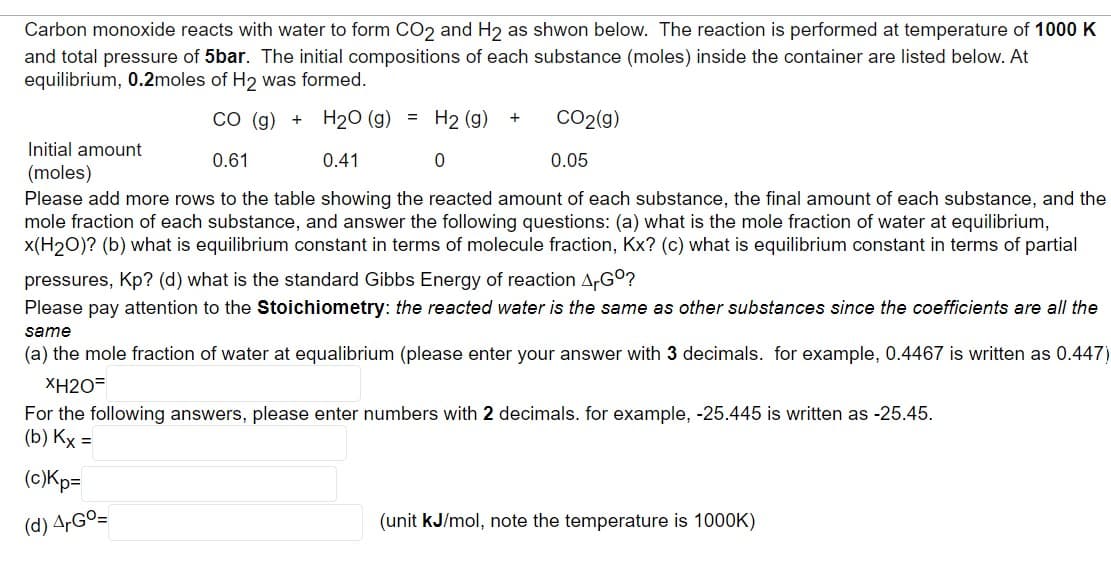Carbon monoxide reacts with water to form CO2 and H2 as shwon below. The reaction is performed at temperature of 1000 K and total pressure of 5bar. The initial compositions of each substance (moles) inside the container are listed below. At equilibrium, 0.2moles of H₂ was formed. CO (g) + H₂O (g) = H2 (g) + Initial amount (moles) 0.61 0.41 0 0.05 Please add more rows to the table showing the reacted amount of each substance, the final amount of each substance, and th mole fraction of each substance, and answer the following questions: (a) what is the mole fraction of water at equilibrium, x(H₂O)? (b) what is equilibrium constant in terms of molecule fraction, Kx? (c) what is equilibrium constant in terms of partial pressures, Kp? (d) what is the standard Gibbs Energy of reaction ArGº? Please pay attention to the Stoichiometry: the reacted water is the same as other substances since the coefficients are all the same (a) the mole fraction of water at equalibrium (please enter your answer with 3 decimals. for example, 0.4467 is written as 0.44 XH2O= For the following answers, please enter numbers with 2 decimals. for example, -25.445 is written as -25.45. (b) Kx = (c)Kp= (d) 4,Gº= CO2(g) (unit kJ/mol, note the temperature is 1000K)
Carbon monoxide reacts with water to form CO2 and H2 as shwon below. The reaction is performed at temperature of 1000 K and total pressure of 5bar. The initial compositions of each substance (moles) inside the container are listed below. At equilibrium, 0.2moles of H₂ was formed. CO (g) + H₂O (g) = H2 (g) + Initial amount (moles) 0.61 0.41 0 0.05 Please add more rows to the table showing the reacted amount of each substance, the final amount of each substance, and th mole fraction of each substance, and answer the following questions: (a) what is the mole fraction of water at equilibrium, x(H₂O)? (b) what is equilibrium constant in terms of molecule fraction, Kx? (c) what is equilibrium constant in terms of partial pressures, Kp? (d) what is the standard Gibbs Energy of reaction ArGº? Please pay attention to the Stoichiometry: the reacted water is the same as other substances since the coefficients are all the same (a) the mole fraction of water at equalibrium (please enter your answer with 3 decimals. for example, 0.4467 is written as 0.44 XH2O= For the following answers, please enter numbers with 2 decimals. for example, -25.445 is written as -25.45. (b) Kx = (c)Kp= (d) 4,Gº= CO2(g) (unit kJ/mol, note the temperature is 1000K)
Chemistry
10th Edition
ISBN:9781305957404
Author:Steven S. Zumdahl, Susan A. Zumdahl, Donald J. DeCoste
Publisher:Steven S. Zumdahl, Susan A. Zumdahl, Donald J. DeCoste
Chapter13: Chemical Equilibrium
Section: Chapter Questions
Problem 128IP: The hydrocarbon naphthalene was frequently used in mothballs until recently, when it was discovered...
Related questions
Question
plz help answer all

Transcribed Image Text:Carbon monoxide reacts with water to form CO₂ and H2 as shwon below. The reaction is performed at temperature of 1000 K
and total pressure of 5bar. The initial compositions of each substance (moles) inside the container are listed below. At
equilibrium, 0.2moles of H2 was formed.
CO (g) + H₂O (g) = H2 (g) +
Initial amount
(moles)
CO₂(g)
0.05
0.61
0.41
0
Please add more rows to the table showing the reacted amount of each substance, the final amount of each substance, and the
mole fraction of each substance, and answer the following questions: (a) what is the mole fraction of water at equilibrium,
x(H₂O)? (b) what is equilibrium constant in terms of molecule fraction, Kx? (c) what is equilibrium constant in terms of partial
pressures, Kp? (d) what is the standard Gibbs Energy of reaction ArGº?
Please pay attention to the Stoichiometry: the reacted water is the same as other substances since the coefficients are all the
same
(a) the mole fraction of water at equalibrium (please enter your answer with 3 decimals. for example, 0.4467 is written as 0.447)
XH2O=
For the following answers, please enter numbers with 2 decimals. for example, -25.445 is written as -25.45.
(b) Kx =
(c)Kp=
(d) ArGº=
(unit kJ/mol, note the temperature is 1000K)
Expert Solution
This question has been solved!
Explore an expertly crafted, step-by-step solution for a thorough understanding of key concepts.
Step by step
Solved in 5 steps

Knowledge Booster
Learn more about
Need a deep-dive on the concept behind this application? Look no further. Learn more about this topic, chemistry and related others by exploring similar questions and additional content below.Recommended textbooks for you

Chemistry
Chemistry
ISBN:
9781305957404
Author:
Steven S. Zumdahl, Susan A. Zumdahl, Donald J. DeCoste
Publisher:
Cengage Learning

Chemistry: An Atoms First Approach
Chemistry
ISBN:
9781305079243
Author:
Steven S. Zumdahl, Susan A. Zumdahl
Publisher:
Cengage Learning


Chemistry
Chemistry
ISBN:
9781305957404
Author:
Steven S. Zumdahl, Susan A. Zumdahl, Donald J. DeCoste
Publisher:
Cengage Learning

Chemistry: An Atoms First Approach
Chemistry
ISBN:
9781305079243
Author:
Steven S. Zumdahl, Susan A. Zumdahl
Publisher:
Cengage Learning


Principles of Modern Chemistry
Chemistry
ISBN:
9781305079113
Author:
David W. Oxtoby, H. Pat Gillis, Laurie J. Butler
Publisher:
Cengage Learning